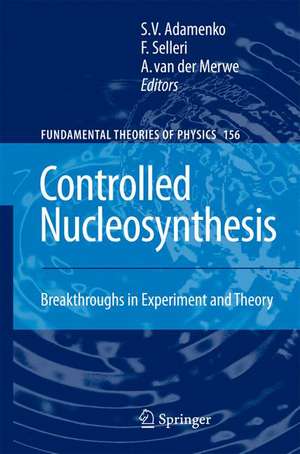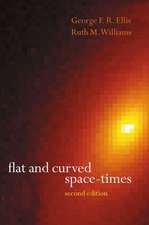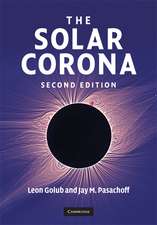Controlled Nucleosynthesis: Breakthroughs in Experiment and Theory: Fundamental Theories of Physics, cartea 156
Editat de Stanislav Adamenko, Franco Selleri, Alwyn van der Merween Limba Engleză Hardback – 28 iun 2007
| Toate formatele și edițiile | Preț | Express |
|---|---|---|
| Paperback (1) | 1240.47 lei 6-8 săpt. | |
| SPRINGER NETHERLANDS – 18 noi 2010 | 1240.47 lei 6-8 săpt. | |
| Hardback (1) | 1249.45 lei 6-8 săpt. | |
| SPRINGER NETHERLANDS – 28 iun 2007 | 1249.45 lei 6-8 săpt. |
Din seria Fundamental Theories of Physics
- 20%
 Preț: 1002.37 lei
Preț: 1002.37 lei -
 Preț: 426.56 lei
Preț: 426.56 lei - 20%
 Preț: 819.48 lei
Preț: 819.48 lei - 18%
 Preț: 779.26 lei
Preț: 779.26 lei - 18%
 Preț: 955.25 lei
Preț: 955.25 lei - 18%
 Preț: 950.52 lei
Preț: 950.52 lei - 24%
 Preț: 794.89 lei
Preț: 794.89 lei - 18%
 Preț: 948.47 lei
Preț: 948.47 lei - 15%
 Preț: 589.80 lei
Preț: 589.80 lei - 18%
 Preț: 1229.73 lei
Preț: 1229.73 lei - 15%
 Preț: 587.83 lei
Preț: 587.83 lei - 18%
 Preț: 1236.06 lei
Preț: 1236.06 lei - 18%
 Preț: 946.87 lei
Preț: 946.87 lei -
 Preț: 394.87 lei
Preț: 394.87 lei - 18%
 Preț: 954.93 lei
Preț: 954.93 lei - 18%
 Preț: 1241.10 lei
Preț: 1241.10 lei - 18%
 Preț: 954.93 lei
Preț: 954.93 lei - 18%
 Preț: 953.35 lei
Preț: 953.35 lei - 18%
 Preț: 948.92 lei
Preț: 948.92 lei - 15%
 Preț: 648.05 lei
Preț: 648.05 lei - 18%
 Preț: 1232.09 lei
Preț: 1232.09 lei - 18%
 Preț: 996.78 lei
Preț: 996.78 lei - 18%
 Preț: 946.41 lei
Preț: 946.41 lei - 15%
 Preț: 640.24 lei
Preț: 640.24 lei - 15%
 Preț: 636.80 lei
Preț: 636.80 lei -
 Preț: 391.79 lei
Preț: 391.79 lei - 18%
 Preț: 780.19 lei
Preț: 780.19 lei -
 Preț: 391.79 lei
Preț: 391.79 lei - 15%
 Preț: 649.06 lei
Preț: 649.06 lei -
 Preț: 397.76 lei
Preț: 397.76 lei - 24%
 Preț: 586.69 lei
Preț: 586.69 lei - 15%
 Preț: 644.95 lei
Preț: 644.95 lei - 18%
 Preț: 1228.15 lei
Preț: 1228.15 lei
Preț: 1249.45 lei
Preț vechi: 1523.72 lei
-18% Nou
Puncte Express: 1874
Preț estimativ în valută:
239.08€ • 249.13$ • 197.96£
239.08€ • 249.13$ • 197.96£
Carte tipărită la comandă
Livrare economică 03-17 aprilie
Preluare comenzi: 021 569.72.76
Specificații
ISBN-13: 9781402058738
ISBN-10: 140205873X
Pagini: 800
Ilustrații: XVI, 782 p.
Dimensiuni: 155 x 235 x 47 mm
Greutate: 1.36 kg
Ediția:2007
Editura: SPRINGER NETHERLANDS
Colecția Springer
Seria Fundamental Theories of Physics
Locul publicării:Dordrecht, Netherlands
ISBN-10: 140205873X
Pagini: 800
Ilustrații: XVI, 782 p.
Dimensiuni: 155 x 235 x 47 mm
Greutate: 1.36 kg
Ediția:2007
Editura: SPRINGER NETHERLANDS
Colecția Springer
Seria Fundamental Theories of Physics
Locul publicării:Dordrecht, Netherlands
Public țintă
ResearchCuprins
Approach to the Problem.- Prehistory.- Self-Organizing Nucleosynthesis in Superdense Plasma.- Experimental Setup.- Some Experimental Results.- Optical Emission of a Hot Dot (HD).- Measurements of X-ray Emission of HD.- Registration of Fast Particles from the arget Explosion.- Experiments on the Neutralization of Radioactivity.- Isotope and Element Compositions of Target Explosion Products.- Synthesis of Superheavy Elements in the Explosive Experiments.- On the Detection of Superheavy Elements in Target Explosion Products.- Physical Model and Discovery of Superheavy Transuranium Elements Produced in the Process of Controlled Collapse.- Preliminary Résumé of Obtained Results, Theories, and Physical Models.- Stability of Electron-Nucleus form of Matter and Methods of Controlled Collapse.- Nuclear Combustion and Collective Nucleosynthesis.
Textul de pe ultima copertă
This book ushers in a new era of experimental and theoretical investigations into collective processes, structure formation, and self-organization of nuclear matter. It reports the results of experiments wherein for the first time the nuclei constituting our world (those displayed in Mendeleev's table as well as the super-heavy ones) have been artificially created. Pioneering breakthroughs are described, achieved at the "Proton-21" Laboratory, Kiev, Ukraine, in a variety of new physical and technological directions.
A detailed description of the main experiments, their analyses, and the interpretation of copious experimental data are given, along with the methodology governing key measurements and the processing algorithms of the data that empirically confirm the occurrence of macroscopic self-organizing processes leading to the nuclear transformations of various materials. The basic concepts underlying the initiation of self-sustaining collective processes that result in the formation of nuclear structures are also examined.
How to realize nucleosynthesis of stable nuclei in the laboratory? Why are metallic meteorites of iron or nickel-iron? Could the iron be nuclear fuel and could an iron star blow up as a supernova? And what could be the energy source of such an explosion? Is it possible to obtain nuclear energy from any terrestrial substance without producing radioactivity? Do super-heavy (Migdal's) nuclei exist, and is it possible to synthesize them in the laboratory? What physical mechanisms could one use to control nuclear transformations and particularly the sign of the overall energy balance involved?
Answers to these and other intriguing questions are to be found in this book.
Audience:
University and research libraries, scientists and researchers, other professionals, lecturers, and graduate students
A detailed description of the main experiments, their analyses, and the interpretation of copious experimental data are given, along with the methodology governing key measurements and the processing algorithms of the data that empirically confirm the occurrence of macroscopic self-organizing processes leading to the nuclear transformations of various materials. The basic concepts underlying the initiation of self-sustaining collective processes that result in the formation of nuclear structures are also examined.
How to realize nucleosynthesis of stable nuclei in the laboratory? Why are metallic meteorites of iron or nickel-iron? Could the iron be nuclear fuel and could an iron star blow up as a supernova? And what could be the energy source of such an explosion? Is it possible to obtain nuclear energy from any terrestrial substance without producing radioactivity? Do super-heavy (Migdal's) nuclei exist, and is it possible to synthesize them in the laboratory? What physical mechanisms could one use to control nuclear transformations and particularly the sign of the overall energy balance involved?
Answers to these and other intriguing questions are to be found in this book.
Audience:
University and research libraries, scientists and researchers, other professionals, lecturers, and graduate students












